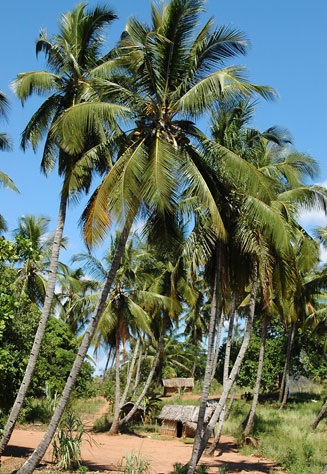Cocos nucifera (Coconut
Palm)
Life
> eukaryotes >
Archaeoplastida >
Chloroplastida
>
Charophyta > Streptophytina > Plantae (land plants)
> Tracheophyta (vascular plants) > Euphyllophyta > Lignophyta (woody plants)
> Spermatophyta (seed plants) > Angiospermae (flowering
plants)
> Monocotyledons > Order: Arecales > Family: Arecaceae
 |
|
|
Cocos nucifera (Coconut palm). [photo John E. Burrows ©] |
|
Coconut Palms are native to the Indo-Pacific Ocean region
and grow at the top of beaches, at the limit of wave action. They are grown
in large plantations and are used for producing many products, such as coconut
oil (from the white endosperm in the coconut), wine ('toddy'), spirit ('arrack') and coir matting. The white endosperm is used
in cooking and confectionery.
The Coconut Palm Cocos nucifera is believed to have
evolved in the Indo-Pacific Ocean region which is where its greatest genetic
diversity occurs. Coconuts are seeds adapted for water-born dispersal and can
remain viable after having floated in the sea for six months or more. Coconut
seeds wash up on tropical island shores where they start germinating at the
upper limit of wave reach, which is where the outer edge of tropical beach
thicket occurs. Male and female flowers are on the same plant (monoecious) so a
single coconut seed is able to start a new colony. Peak coconut
production occurs when trees are about 30-60 years old but trees are still
productive when over a hundred years old.
The inside of a coconut consists of endosperm which is
liquid in a green nut and solid white in a ripe one. The contents of coconuts
must have been eaten or drunk by people in the Indo-Pacific region from the
earliest of times. Colonisation of new islands depended on the presence of
coconuts to provide food and drink, and coconuts were probably carried on board
boats as sources of food and drink during long journeys of discovery. It seems
that islands without coconuts were planted with them. For instance, it is
thought that Polynesians introduced coconuts to Hawaii in the 12th
century.
Coconuts were introduced to the Atlantic region by the
Portuguese. They were brought back from the Indian Ocean in 1498 by Vasco da
Gama's expedition and in the 1500's, the Portuguese established coconut palms
along the West African coast, on the Cape Verde archipelago and on the coastline
of Brazil. Coconuts had been introduced to the West Indies by 1582. Commercial
planting of coconut palms began in the mid-1800's and was linked to the
abolition of slavery in the British Empire in 1835: high labour crops such as
sugar cane and cotton were in some areas (e.g. the Seychelles) replaced by low
labour coconut plantations. Palms in large commercial plantations of the
Indo-Pacific region (e.g. Philippines) now outnumber by a large margin those
growing wild. World production is now about 40 billion nuts per year, these
being grown mainly in Indonesia, the Philippines, India and Sri Lanka.
Uses
-
The liquid or solid endosperm is eaten or drunk raw, or
used in a huge variety of recipes for cooked food.
-
The solid endosperm ('nut meat') is dried in the sun or
in ovens fueled by burning the husks, to produce copra which has been
the main form in which coconut has been exported as it keeps well. It
contains about 60-70% coconut
oil, but the oil is slow to become rancid. Grated copra is used in
confectionery. The endosperm consists of saturated cholestrol-free fat as
well as sugars, potassium and phosphorus.
-
Coconut oil is extracted from copra and used in
a variety of ways including in cooking, margarine and soaps. From about
1850 to 1950, coconuts were the main commercial source of vegetable oils.
They were then overtaken by soyabean and then by Oil Palm (Elaeis).
-
Coconut milk is produced by mixing grated
coconut with hot water, producing a milky-white liquid containing coconut
oil and aromatic substances. The milk is used in a wide variety of Asian
recipes. An acceptible easy solution to producing coconut milk in your
kitchen is to mix dessicated coconut with hot water in an electric
blender.
-
Leaves are used for constructing shelters
and are also used in weaving baskets, etc.
-
Timber (called porcupine wood) is used in
buildings.
-
Outer fibrous covering of the coconut (the mesocarp)
is used for producing coir matting and rope.
-
Apical buds of old trees are canned as palm-hearts
(cutting them off kills the tree).
-
The axis of the inflorescence is tapped for palm juice,
which when fermented produces palm wine, termed toddy (toddy
is also produced from other palm genera as well). When evaporated, the juice produces
a crude sugar called jaggery (term also used for crude sugars
produced from other palm species and from sugar cane). Toddy is distilled to
produce the alcoholic spirit called arrack.
Links
Publications
-
Mabberley, D.J. 1987. The Plant Book. A
Portable Dictionary of the Higher Plants. Cambridge University Press,
Cambridge.
-
Sauer, J.D. 1993. Historical geography of
crop plants - a select roster. CRC Press, Boca Raton, Florida.
-
van Wyk, B.-E. 2005. Food Plants of the World -
Identification, Culinary Uses and Nutritional Value. Briza, Pretoria.
Text by Hamish Robertson |
